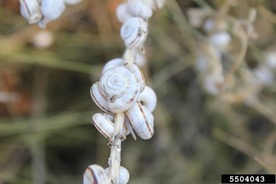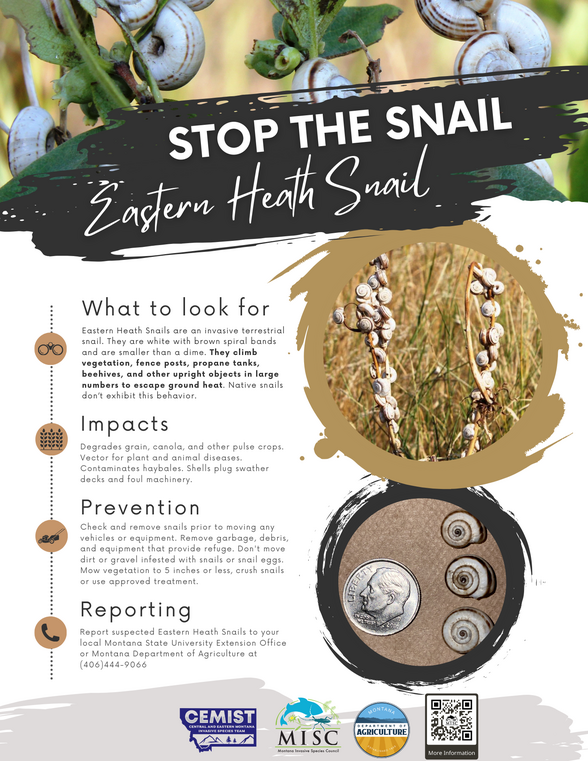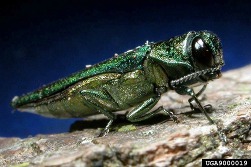 |

Eastern Heath Snails Identified in Lewistown
Lewistown, M.T. The Fergus Conservation District announced the detection of Eastern Heath Snails (Xerolenta obvia) in the Lewistown area. This is the first detection of the snail in Fergus County. This invasive species, native to Europe, poses a potential threat to local agriculture and natural habitats.
The USDA – Animal & Plant Health Inspection Service confirmed the discovery after a report was sent to the Montana Invasive Species Council in late July. Subsequent sampling at the reported site revealed an established but isolated population.
First detected near Belt, MT in 2012 this snail has since spread into Chouteau, Cascade, and Judith Basin Counties. Unlike native land snails, Eastern Heath Snails climb vegetation, propane tanks, fence posts, or vehicles and gather in large numbers called massing to escape ground heat, allowing them to be easily transported by people to new areas.
A multi-stakeholder work group has been established. Plans to mitigate the Lewistown population of Eastern Heath Snails are currently under development and the Fergus Conservation District will hold a public meeting on Sept. 12 at the Eagles Lodge in Lewistown from 6 p.m. to 8 p.m. to raise awareness and discuss plans moving forward. The public is encouraged to report suspected Eastern Heath Snail sightings to their local county extension office and to be diligent when transporting equipment and materials to ensure no snails hitch a ride.
More information about the Eastern Heath Snail can be found at https://invasivespecies.mt.gov/montana-invasive-species/eastern-heath-snail.
|
 |

Emerald ash borer detected in LaMoure County, North Dakota
BISMARCK, N.D. This week, adult emerald ash borers (EAB) were collected from a trap placed in LaMoure County, nine miles north of Edgeley, North Dakota. Upon follow-up from North Dakota Department of Agriculture (NDDA) staff, additional larvae were collected and have been officially confirmed as EAB. The detection is the first in North Dakota, and it becomes the 37th state to detect EAB.
“The North Dakota Department of Agriculture and our partners have been preparing for emerald ash borer’s eventual arrival for many years,” Agriculture Commissioner Doug Goehring said. “We have been placing and monitoring traps each summer and promoting awareness through outreach events, training and communication with the public. Now that it is unfortunately here, we urge North Dakota residents and travelers to be proactive to keep EAB from spreading.”
EAB is a wood boring insect originally from Asia, first found in the U.S. in 2002. It has since spread to 37 states and killed hundreds of millions of ash trees.
“North Dakota has more than 90 million ash trees that are at risk in native, rural and urban forests,” State Forester Tom Claeys said. “Ash trees make up between 20% - 80% of the trees along city streets and parks. Unless treated, infested ash trees can be killed in a few years.”
NDDA maintains a quarantine restricting movement of regulated commodities from infested areas. The quarantine will be extended to LaMoure County. Travelers should leave firewood at home and purchase or gather from local sources. Moving regulated materials from a quarantined to a non-quarantined area can result in civil penalties of up to $5,000.
NDDA will collaborate with the North Dakota Forest Service, and North Dakota State University Extension to determine the extent of the infestation, continue monitoring ash trees and conduct outreach in the coming months. The ice storm that the area endured in December of 2023 will complicate efforts to find infested trees due to tree damage sustained in the storm.
Residents should check their ash trees for signs of an infestation, which include dieback, S-shaped tunnels, also known as serpentine galleries, under the bark, small D-shaped exit holes and woodpecker activity in the upper canopy of the trees.
One option to protect high-value trees are insecticide treatments. Treatments are not recommended until EAB is detected within 15 miles. Residents who choose to treat their ash trees are strongly urged to select a reputable tree service company with a certified applicator able to do these treatments. Most treatment options are restricted use and can only be done by a tree care professional.
For more information, or to report a tree you think may be infested, please visit www.ndda.nd.gov/eab [ndda.nd.gov].
|
Zebra Mussels Discovered in South Golden Lake, ND
The North Dakota Game and Fish Department has confirmed the presence of invasive zebra mussels in South Golden Lake, Steele County, after detecting zebra mussel veligers in routine net samples.
Department aquatic nuisance species coordinator Ben Holen said subsequent follow-up sampling found additional adult mussels in the lake.
The 331-acre lake is a popular recreation destination located 13 miles southwest of Hatton.
Due to its immediate downstream connection, North Golden will be listed with South Golden Lake as Class I ANS infested waters. These lakes join Lake Elsie, Twin Lakes, Lake LaMoure, Lake Ashtabula, lower portion of the Sheyenne River, and the Red River in this designation. Emergency rules will go into effect immediately to prohibit the movement of water away from the lake, including water for transferring bait. Notices will be posted at lake access sites.
Zebra mussels are just one of the nonnative aquatic species that threaten our waters and native wildlife. After using any body of water, people must remember to follow North Dakota regulations:
- Remove aquatic vegetation before leaving the water access and do not import into North Dakota.
- Drain all water before leaving the water access.
- Remove drain plugs and devices that hold back water and leave open and out during transport.
- Do not import aquatic bait into the state. For Class I ANS infested waters, aquatic bait cannot be transported away from the water. In all other areas, bait must be transported in a container that holds 5 gallons or less. It is illegal to dump unused bait on shore or into the lake.
In addition to North Dakota regulations, the Game and Fish Department strongly recommends the following:
- Avoid mooring watercraft in zebra mussels infested waters.
- Clean – remove plants, animals and excessive mud prior to leaving a water access.
- Drain – drain all water prior to leaving a water access.
- Dry – allow equipment to dry completely or disinfect before using again. This includes boat docks and boat lifts. North Dakota Administrative Code states that “All docks, lifts and related equipment must be dried and left out of water for at least 21 days before they may be placed in another water.” For more information about ANS in North Dakota, options for disinfection, or to report a possible ANS, visit https://gf.nd.gov/ans [links-2.govdelivery.com].

|